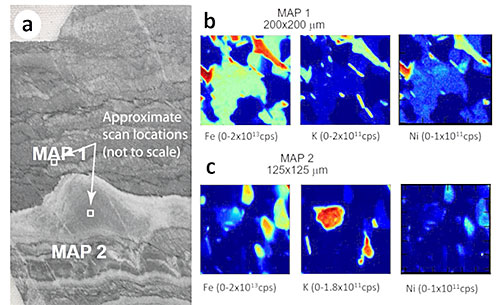3.7-billion-year-old Structures Formed by Tectonics, not Life
The 3.7-billion-year-old structures were considered the first evidence for life on the planet, however, new evidence suggests differently
November 30, 2018
 enlarge
enlarge
Image a) shows a photograph of the rock sample, while the collection of x-ray images b) and c), obtained at the SRX beamline, show element distributions within the indicated regions of image a). These chemical maps reveal fine-scale chemical and mineralogical variations that were not captured in previously published analyses, disproving the erroneous conclusions that were previously made about the role of biology in forming these rocks. Image courtesy of A. Allwood, Nature 563, 241 (2018)
The Science
Scientists re-examined early “fossils” and found the structures to be of geological, not biological, origin.
The Impact
Dating the first beginnings of life on Earth has important implications for understanding how life emerged and evolved. It also has implications for the search of life on Mars and other planets.
Summary
In a recent study, scientists reevaluate evidence of life in 3.7-billion-year-old rock structures and found that the structures were of geological origin and not as previous thought of biological origin. Until this recent new study, the structures were considered the earliest evidence for life on Earth.
Finding evidence and dating the first beginnings of life on Earth has important implications for our understanding on how life emerged and evolved on Earth. This knowledge can also help scientists for the search of life on Mars or other planets.
The previous studies on these rock samples employed millimeter scale information using laser ablation analysis to determine the origin of the formations. For this new study the team of scientists used micrometer x-ray florescence analysis at the National Synchrotron Light Source II (NSLS-II), a U.S. Department of Energy (DOE) Office of Science User Facility located at DOE’s Brookhaven National Laboratory.
Using the Submicron Resolution X-ray (SRX) beamline, they revealed crucial new evidence based on the elemental make-up of the rock structures. This evidence supported the conclusion that the rock formations are of non-biological origin.
Related Links
Feature Story: “3.7-billion-year-old Structures Formed by Tectonics, not Life”
Contact
Abigail C. Allwood
Jet Propulsion Laboratory, California Institute of Technology
abigail.c.allwood@jpl.nasa.gov
Joel A. Hurowitz
Stony Brook University
joel.hurowitz@stonybrook.edu
Publications
A. Allwood, M. T. Rosing, D. T. Flannery, J. A. Hurowitz, C. M. Heirwegh. Reassessing evidence of life in 3,700-million-year-old rocks of Greenland. Nature 563, 241 (2018) DOI: 10.1038/s41586-018-0610-4
Funding
Part of this research was carried out at the Jet Propulsion Laboratory, California Institute of Technology, under a contract with the National Aeronautics and Space Administration (NASA). Funding for the work was provided by the NASA Mars 2020 PIXL flight project. Additional funding was provided through the Stony Brook University-Brookhaven National Laboratory Seed Grant program. This research used the Submicron Resolution X-Ray Spectroscopy (SRX) Beamline 5-ID of the National Synchrotron Light Source II (NSLS-II), a U.S. Department of Energy (DOE) Office of Science User Facility operated for the DOE Office of Science by Brookhaven National Laboratory under Contract No. DE-SC0012704.
2018-17482 | INT/EXT | Newsroom









